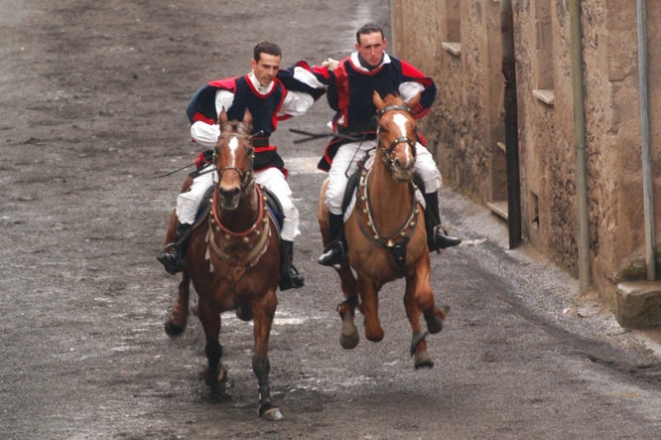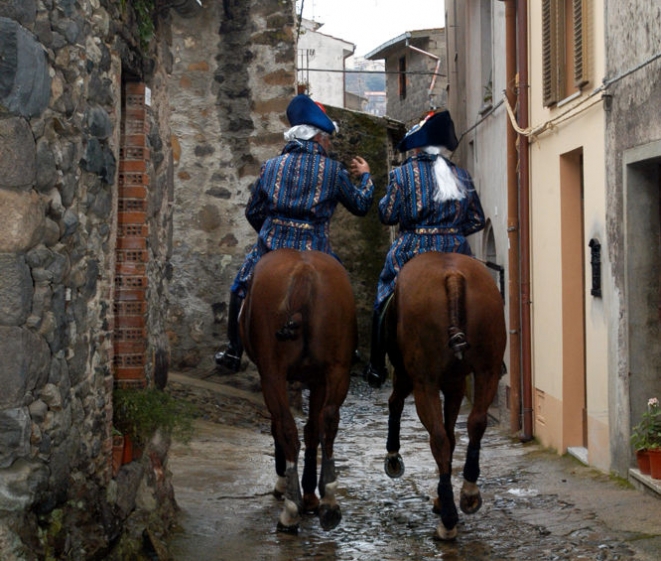The reckless Carrela e'Nanti of Santu Lussurgiu
One of the most exciting horse racing of Sardinian carnival
On the eastern side of the subregion of Montiferru, there is Santulussurgiu, a pretty village with a beautiful historic center where has been preserved an ancient cobbled which is one of the more important features of the village. But the village of Santulussurgiu is especially famous for Sa Carrela e' Nanti.
Literally translatable as "the road ahead".
We are talking about the most daring, challenging, daring and fascinating horse racing that exist in Sardinia, that became over time a must for lovers of racing and of the traditions of the Sardinian Carnival.
It is a very ancient event of extraordinary participation of the audience that, together with the Sartiglia of Oristano and the Ardia of Sedilo, it is one of the deepest event of Sardinian folklore that celebrates the indissoluble relationship between man and horse.
To give the name of the event is the twisty "Carrela e' Nanti", the current via Roma, in the historical center of the village.

This way in the last three days of the carnival becomes the path through which the daring swoop teams, consisting of two, three or four horses, taken at a gallop along the street jammed with spectators on both sides.
The backdrop of the historic center of Santu Lussurgiu is spectacular. Ancient stone houses, small curves and gentle climbs. The horses, before the descent, are gathered at "s'iscappadorzu", the meeting point from where they start, to take, immediately, the steep descent.
The riders rush with their mighty thoroughbred and you may hear the sounds and the incitement of the crowd that cheers from time to time the various teams of horses that follow one another. Each one with its own choreography, its posture, its technique and every rider with his dose of madness, bravery, recklessness and audacity that make attend the event, also from afar, an charged-up moment.
The mask is a must. It consists in masking the rider and, about this, there are no precise rules. Each jockey can dress up as he prefers. The costume can be rich in colors and fantasy, it can be shaped as modern masks or today characters or recall the old traditional dress of the village; but just paint the face of pitch could be enough. The important thing is to masquerade. In every self-respecting Carrela, in fact, the riders are strictly masked.
Already from the week before, the soil begins to cover via Roma that becomes animated for the first tests of the knights riding their horses. Starts from there the true waiting for the ancient district of Biadorru, culminating on Carnival Sunday, where the people flock to the roadside to see the incredible spectacle that the Carrela e'Nanti offers. Only that afternoon it will officially start the dance.

Sa Carrela finally begins. The astounded crowd sees the skills of the riders. The breakneck speed of the horses, the acrobatics of the jockeys, the magnificent setting where the event takes place, the magic that surrounds each race, are elements that are found on time and each year attract more and more people. But there is another important moment of this event: "su lunis de sa pudda" (Monday of the hen).
In ancient times the Monday after the race were hung, at about the halfway, some alive hens upside down. The skill of the riders was to cut off their heads with a sharp blow of a stick, on the way down, riding their horses. Over the years this cruel ritual was fortunately abandoned and chickens have been replaced by rag hens hanging by a thread cross the street.
On Mardi Gras, the Carrela ends with the final award of the top three teams and jockeys who shot down the highest number of "fake" hens. Via Roma, the crossroads for three days of horses and riders, masks, gestures, acrobatics and sound, goes back to normal, but it is only a pause, a parenthesis, of just under a year, because the next carnival will be ready to turn again and background to another wild and unforgettable ride.